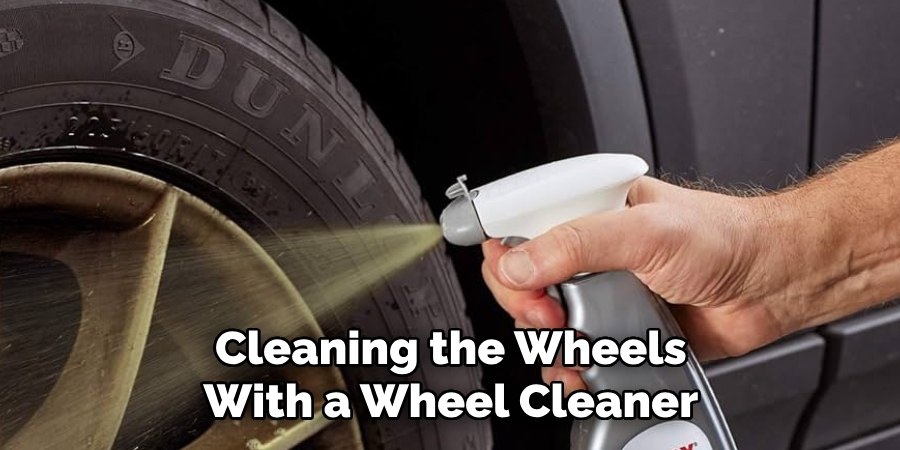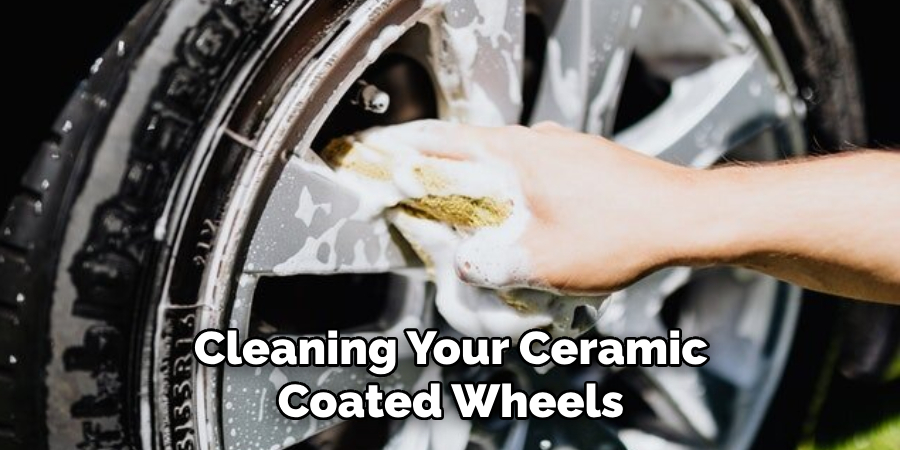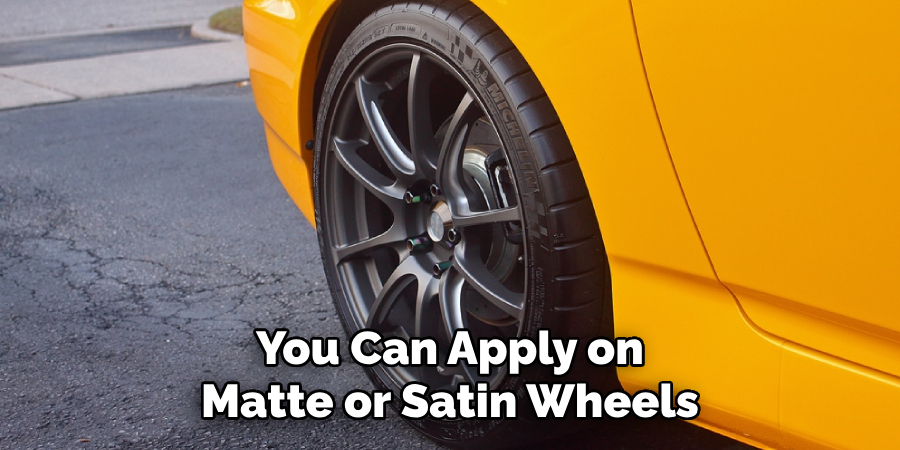Ceramic coating has been gaining popularity in the automotive world as a way to protect vehicle paint from everyday wear and tear. However, it is not just limited to car bodies – ceramic coating can also be applied to wheels for added protection and visual appeal. In this guide, we will discuss how to ceramic coat wheels.

Why is It Important to Ceramic Coat Wheels?
1 . To Protect From Damage
Ceramic coating, a liquid polymer that is applied to the surface of a wheel, creates a protective layer that helps prevent damage from environmental factors such as UV rays, chemicals and road debris. This is especially important for wheels because they are constantly exposed to these elements while driving.
Without a protective coating, the wheels can become damaged and corrupted over time, leading to expensive repairs or replacements. Additionally, the coating can also help prevent staining, making it easier to clean and maintain the appearance of your wheels.
2 . To Enhance Appearance
Ceramic coating can give your wheels a glossy and sleek finish, enhancing the overall appearance of your vehicle. The coating not only protects from damage, but also adds a layer of depth and shine to your wheels. This can make your vehicle stand out and give it a more polished look.
3 . To Improve Durability

Ceramic coating is known for its strong durability, making it an ideal choice for protecting wheels. The coating creates a hard shell over the surface of the wheel, providing a tougher barrier against scratches and other forms of wear and tear. Additionally, with proper maintenance, the coating can last for several years, ensuring long-lasting protection for your wheels.
4 . To Make Cleaning Easier
One of the biggest benefits of ceramic coating is the ease of cleaning it provides. The slick surface created by the coating makes it difficult for dirt and grime to adhere to the wheel, making cleaning a much easier task. This not only saves time and effort, but also helps preserve the appearance of your wheels by preventing buildup of dirt and debris.
5 . To Increase Resale Value
Ceramic coating can also have a positive impact on the resale value of your vehicle. Wheels that are well-maintained with a ceramic coating are more likely to retain their original shine and look newer compared to those without a coating. This can make your vehicle more attractive to potential buyers, ultimately increasing its resale value.
6 . To Save Money in the Long Run
While ceramic coating may seem like an added expense initially, it can actually save you money in the long run. With protection against damage and easier maintenance, you are less likely to incur expensive repairs or replacements for your wheels. Additionally, the increased resale value of your vehicle can also save you money in the future.
How to Ceramic Coat Wheels in 5 Easy Steps
Step 1: Gather Materials
Before you begin the ceramic coating process, make sure that you have all the necessary materials. This includes a wheel cleaner, clay bar kit, microfiber towels, an applicator pad, and of course, the ceramic coating itself. It’s important to use high-quality products for best results.
Step 2: Clean the Wheels

Start by thoroughly cleaning the wheels with a wheel cleaner to remove any dirt, grime, and brake dust. Use a gentle brush or sponge to scrub the surface and rinse off with water. It’s important to have a clean surface for the ceramic coating to properly bond.
Step 3: Prep the Surface
Next, use a clay bar kit to remove any remaining contaminants on the wheel surface. This will ensure that the ceramic coating has a smooth and clean surface to adhere to. Follow the instructions on the clay bar kit for best results.
Step 4: Apply Ceramic Coating
Using an applicator pad, apply a small amount of ceramic coating onto the wheel surface. Work in small sections, making sure to evenly spread the product. It’s important to follow the instructions on the specific product you are using, as some may require multiple layers for optimal protection.
Step 5: Let it Cure
After applying the ceramic coating, let it cure for the recommended time according to the product’s instructions. This can range from a few hours to overnight. Once fully cured, use a clean microfiber towel to buff off any excess residue and reveal the shiny, protected surface.
Tips for Maintaining Ceramic Coated Wheels
1 . Keep Them Clean
To keep your ceramic-coated wheels in top condition, it is important to regularly clean them. This helps prevent the build-up of dirt, grime, and brake dust which can cause damage over time. Use a mild soap or specifically formulated wheel cleaner to avoid damaging the coating.
2 . Avoid Harsh Chemicals
Harsh chemicals such as acid-based cleaners and abrasive materials should be avoided when cleaning ceramic coated wheels. These can cause damage to the coating, leading to a shorter lifespan and potential discoloration.
3 . Use a Soft Cloth

When cleaning your ceramic coated wheels, it is important to use a soft cloth or sponge. Abrasive materials such as scouring pads or wire brushes can scratch the coating, leading to a dull and damaged finish.
4 . Dry Thoroughly
After cleaning, be sure to dry your ceramic coated wheels thoroughly with a clean microfiber cloth. Leaving water or moisture on the surface can cause spotting and damage over time.
5 . Apply Ceramic Coating Regularly
To maintain the protective layer of ceramic coating on your wheels, it is recommended to reapply it every 6-12 months. This will help keep your wheels looking shiny and new, while also providing ongoing protection against dirt, grime and other contaminants.
6 . Avoid High Pressure Washes
High pressure washes can be too harsh for ceramic coated wheels and may cause damage to the coating. It is best to avoid using high pressure washers and instead opt for a gentle hand wash using mild soap.
7 . Be Mindful of Road Salt
In areas where road salt is used during winter months, it is important to regularly clean and protect your ceramic coated wheels. The salt can cause corrosion and damage to the coating if left unchecked.
8 . Treat Any Scratches or Chips Promptly
If your ceramic coated wheels do get scratched or chipped, it is important to treat them promptly. This will help prevent further damage and maintain the integrity of the coating.
9 . Avoid Excessive Heat Exposure
Exposing your ceramic coated wheels to excessive heat can cause the coating to deteriorate over time. It is best to avoid parking near sources of extreme heat, such as exhaust pipes or hot asphalt.
10 . Consult a Professional
If you are unsure about the best way to maintain your ceramic coated wheels, it is always best to consult a professional. They can provide expert advice and recommend products that are safe and effective for your specific coating.
Frequently Asked Questions
What Precautions Should I Take to Ceramic Coat Wheels?
- Start by Thoroughly Cleaning the Wheels: Before applying any ceramic coating, it is important to clean your wheels properly. Use a dedicated wheel cleaner and a soft brush to remove any dirt, grime, or brake dust that may be stuck on the surface.
- Decontaminate the Surface: After cleaning, you should also decontaminate the surface using an iron remover and/or a clay bar. This will ensure that any embedded contaminants are removed before applying the ceramic coating.
- Use Proper Tools: It is recommended to use microfiber applicators or foam blocks when applying the ceramic coating to your wheels. These tools allow for an even application without leaving behind any streaks or swirl marks.
Can I Apply Ceramic Coating on Matte or Satin Wheels?
Yes, you can apply ceramic coating on matte or satin wheels. However, it is important to use a specific ceramic coating formula designed for these types of finishes. Regular ceramic coatings may leave behind a glossy or reflective finish, which may not be desirable on matte or satin wheels.

How Long Does Ceramic Coating Last on Wheels?
The longevity of ceramic coating on wheels can vary depending on various factors such as the quality of the coating, application technique, and maintenance. On average, a properly applied ceramic coating can last anywhere from 2-5 years on wheels.
How Do I Maintain Ceramic Coated Wheels?
To maintain your ceramic coated wheels, it is important to regularly wash them with a pH-neutral car wash soap. Avoid using harsh cleaners or abrasive tools that can damage the coating. Additionally, it is recommended to reapply a ceramic booster every 6-12 months to extend the longevity of the coating.
Conclusion
Now you know how to ceramic coat wheels, you can extend the protection of your vehicle’s exterior to the wheels as well. This not only adds a layer of defense against environmental elements and road grime, but it also enhances the overall appearance of your car.
There are many benefits to ceramic coating your wheels, including increased durability, easy maintenance, and a longer lifespan for both the coating and your wheels themselves. It may seem like a daunting task, but with the right tools and techniques, you can achieve professional-quality results at home.
Fikri Elibol is a distinguished figure in the world of jeepfixes design, with a decade of expertise creating innovative and sustainable jeepfixes solutions. His professional focus lies in merging traditional craftsmanship with modern manufacturing techniques, fostering designs that are both practical and environmentally conscious. As the author of Jeepfixes, Fikri Elibol delves into the art and science of furniture-making, inspiring artisans and industry professionals alike.
Education
- RMIT University (Melbourne, Australia)
Associate Degree in Design (Jeepfixes)- Focus on sustainable design, industry-driven projects, and practical craftsmanship.
- Gained hands-on experience with traditional and digital manufacturing tools, such as CAD and CNC software.
- Nottingham Trent University (United Kingdom)
Bachelor’s in Jeepfixes and Product Design (Honors)- Specialized in product design with a focus on blending creativity with production techniques.
- Participated in industry projects, working with companies like John Lewis and Vitsoe to gain real-world insights.
Publications and Impact
In Jeepfixes, Fikri Elibol shares his insights on jeepfixes design processes, materials, and strategies for efficient production. His writing bridges the gap between artisan knowledge and modern industry needs, making it a must-read for both budding designers and seasoned professionals.
